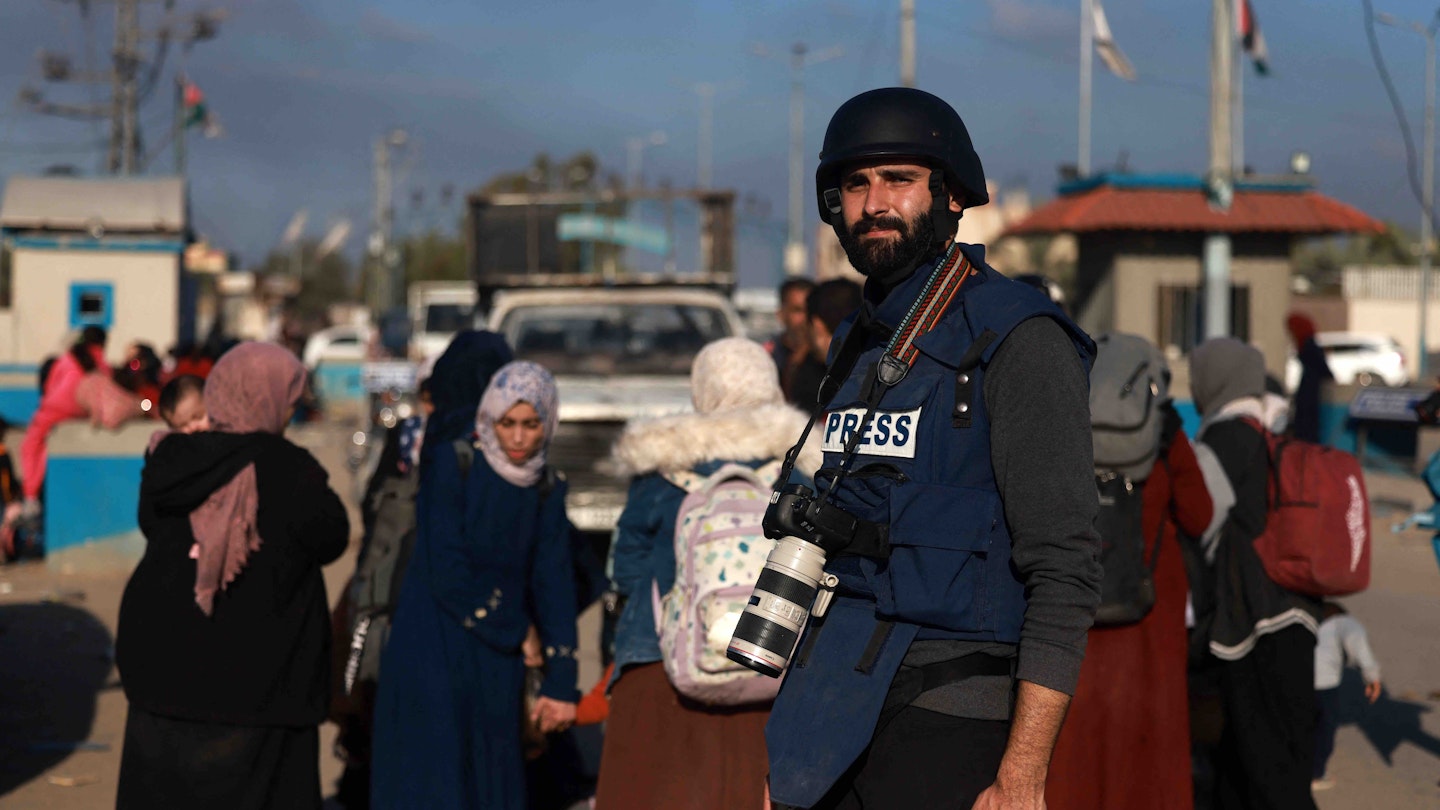For 108 days from 7 October 2023, Gazan photographer Motaz Azaiza captured the horrors of the Israel-Palestine conflict on camera. Buildings destroyed, bodies buried in rubble, children crying and injured from airstrikes, his Instagram feed served the heart-wrenching reality of war to his 18.6 million followers. Then, last month, he made the difficult decision to evacuate to Qatar, explaining online, ‘I spent my whole power on showing the truth and [the war] didn’t stop.’
Days prior to his evacuation, Grazia spoke to Motaz about life in Gaza, where the death toll currently sits at 27,700, according to the most recent Red Cross estimates as Grazia went to press. They also say that more than 1.9 million people have been displaced since Israel took retaliatory action after Palestinian militant group Hamas launched a terror attack on Israel killing 1,200 people and taking a further 240 hostages. At present, 134 hostages remain in Hamas captivity, with The New York Times reporting that at least a fifth of those are presumed dead.
Two hostages, Fernando Simon Marman, 60, and Louis Har, 70, were reunited with their families after being rescued by special forces in a raid in Gaza’s Rafah region on 11 February. But Foreign Secretary David Cameron warned Israel to ‘think very seriously before it takes any further action’ in Rafah, instead calling for ‘an immediate pause in fighting’.
As the conflict rages on, Motaz describes the increasing despair. ‘Every day, I wake up very desperate, feeling hopeless,’ he explains over WhatsApp video call, the first time he had been able to get internet in weeks. ‘I try and find fresh food each day, because there’s no electricity so we can’t store it. I have to find diesel for the car, it’s so difficult to get and expensive – one litre is about $8. There is no internet connection [most of the time], you can’t make phone calls, so there is nothing to even distract you from your anger or pain.

‘I have more than 20 people in my house, people who evacuated Gaza City after the Israeli army entered, so there’s no privacy, there’s not enough food for everyone and we can’t shower. Everything makes you feel as though you want to kill yourself.’
The bombing has been so relentless, death so commonplace, that Motaz says people barely react to it anymore. ‘Even if there is a bombing at the end of a street, you will find people there trying to buy food. It’s so hopeless to stay alive, they may feel scared for a moment but then they will continue their day.’
Before the Israel-Palestine conflict escalated in October, Motaz’s photography was primarily joyful; sunset scenes of a beautiful Gaza and smiling portraits of people from different communities. Behind the camera, his life was still hard, he admits, but ‘a heaven compared to this’. As the eldest son in his family, Motaz was expected to provide for his family, dreaming of life as a travel photographer.
‘I was trying to find myself, find work, get paid more so I could travel because I was crazy about travel photography,’ he explains. ‘But your dreams aren’t your right, because as a Palestinian I can’t even enter the UK. You need plenty of money in the bank to apply for a visa to travel, so life was difficult before the war and now, it’s about suffering.’
In order to capture the human cost of this devastating conflict, Motaz spent months risking his life by heading into war zones, rather than running from them. Some of his photographs are so graphic they come with a content warning on Instagram. ‘My mum worries about my life, but she’s accepted it,’ he says. ‘I am cautious, of course, but sometimes I act like a fool and go into areas that may be bombed. I think, “Fuck the camera, I’ll die,” and keep filming.’
Memorable examples of his recent work include two mothers sitting with their babies among the ruins of a building (far left), and one of a little girl holding two red roses as she walks through a village reduced to rubble. But the most haunting scenes, Motaz says, he doesn’t photograph. ‘They are so awful; they just exist in my memory. The most hurtful thing to see is the babies, seeing one with his brain out... He did nothing – the children are innocent.’
I want the reaction to be on the streets, not in likes or comments.
Motaz Azaiza
With the number of his followers still rising, it’s clear that Instagram has given Motaz the power to show the truth of life in Gaza. Indeed, such is his power that one of the photos that first appeared on social media was voted Time Magazine’s photo of 2023. But Motaz is also quick to criticise the way he has exploded online, bemoaning those telling him to ‘be strong’ on social media. ‘I want the reaction to be on the streets, not in likes or comments,’ he says. ‘Go and show what this image made you feel. I appreciate what people do protesting, or sharing and commenting [on my posts], but it hasn’t stopped anything. Even the war now is about social media, it’s so useless.’
Still, since leaving Gaza, Motaz has started a new life in Qatar, and recently celebrated his 25th birthday. ‘I didn’t expect to even make it to 25,’ he confessed on Instagram. ‘One day, I felt as though something was going to happen to me personally. The war discovered Motaz, but it didn’t make Motaz.’
To support those impacted by the Israel- Palestine conflict, donate to the Red Cross Appeal. Follow @britishredcrossfor details.
